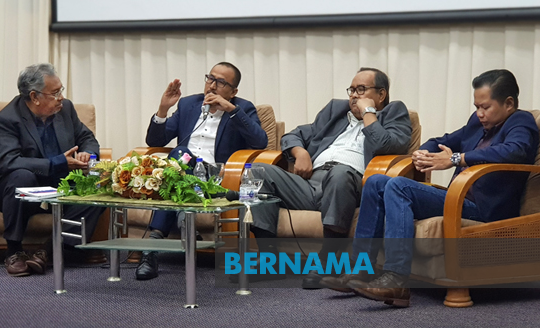Future of newspapers lies in business model: Experts

Former editor of the now-defunct Utusan Malaysia Datuk Zulkefli Hamzah (second frrom left) opined that the magazine sector was the first to be impacted by the digital disruption. (BERNAMA)
By Ali Imran Mohd Noordin
Kuala Lumpur: Since the publication of the world’s first newspaper called Relation aller Fürnemmen und gedenckwürdigen Historien in Strasbourg, Germany, in 1605, the news publishing industry has undergone constant evolution and had its share of ups and downs.
Nonetheless, the print media such as newspapers and magazines managed to find a place in the hearts of the public the world over.
Everything seemed hunky-dory until the 1920s when radio broadcasts begun to eat into the popularity of the dailies where news delivery was concerned. However, with the emergence of Hollywood, the print media won over readers by covering film industry news, promoting new movies and writing about the film stars.
The print industry faced another setback in the 1950s when television came into the picture and made a dent in their readership. Not ready to be beaten, publishers devoted some space for the publication of content related to television programmes which helped them to retain their loyal readers.
Despite the efforts taken to change with the times, the print media continued to face challenges, with the acid test posed by the Internet age being its biggest yet.
In Malaysia, the Internet became popular in the late 1990s and subsequently, the deluge of online news portals and blogs saw them competing head to head with the dailies. In fact, the 1998 political crisis became a game-changer of sorts in the industry as readers, disillusioned with the nation’s mainstream media, shifted their attention to digital platforms.
Friendster and MySpace were among the earliest social media sites that allowed Internet users to share their feelings and opinions. Later Facebook came along and today, hundreds of online sites and chatrooms are available for use.
According to former editor of the now-defunct Utusan Malaysia Datuk Zulkefli Hamzah, the magazine sector was the first to be impacted by the digital disruption.
“After that, it started affecting the newspapers. Currently, the disruption faced by the dailies is becoming increasingly critical.
“Next to be affected will be portals and blogging platforms. We’ve seen blogs or portals that were popular two or three years ago losing their popularity now. These are all related to the changing trends and aspirations of the people,” he said when speaking at a dialogue on the Future of Newspapers in Malaysia, organised by Universiti Sains Islam Malaysia with the cooperation of the Malaysian Press Institute, in Nilai, Negeri Sembilan, last month.
At the same event, former marketing director of NSTP Group Abdul Rahim Mohd Saleh said two important aspects need to be considered in order to ensure the sustainability of any news organisation’s brand.
First, he said, is the business model where the corporate and editorial sections have their own distinct roles.
“The corporate section’s objective is to attract more investors. How much dividend can a share unit worth a ringgit yield? How much is the dividend payable? These should be among the corporate objectives… not interfering with editorial or marketing (affairs),” said the former Universiti Teknologi Mara lecturer.
Another role of the corporate section is to set and provide financial allocations to the other departments of the news organisation. The editorial department can only optimise its functions if it receives sufficient allocation, he said.
Another crucial department is marketing. The editorial and marketing departments have their own audience, with the former’s customers being the readers and the latter’s, advertisers and sponsors.
The second important aspect a news organisation should focus on is winning the trust of its readers. To do this, stressed Abdul Rahim, news outlets should adhere to the principles of integrity when gathering and delivering news.
With the plethora of news sources available today, it is hard to control the dissemination of fake news; as such, media organisations should position themselves as providers of genuine and accurate news.
“Once they’ve built their credibility, they can position their brand as the ‘champion of the people’,” he added.
Abdul Rahim also emphasised the importance of selecting a high-impact slogan to drive a newspaper’s direction as it would help to empower its marketing activities. A dynamic slogan, he pointed out, can restore the newspaper to its former glory.
At the same dialogue, editor of portal Malaysia Indicator Sosongko Yudho said the media should start thinking of a minimalistic operating model but with the capacity for maximum output.
Sosongko, who was previously involved in developing Indonesia’s news-based Metro TV, cited the station’s successful “lean but mean” business model.
He said while the station’s programmes were popular with Indonesian viewers, not many knew that it operated with only two studios.
“If one studio is being used, the other has to be readied for the next programme.
He said for its highly rated talk show titled Mata Najwa, Metro TV generates revenue from various sources, including product placements. But the biggest revenue sources are outside the studio.
“If Mata Najwa goes to the campus (for recording), it can get an audience of over 1,000, for which the station can impose high charges for product placements (by companies) whose target is the youth market. Youths are spending and that’s why they (Metro TV) are going to the campus,” said Sosongko.
Youths in the 20 to 30 age bracket are spending more than those aged above 30, he said, adding that advertisers are willing to pay for product placements but on the condition that Mata Najwa remained popular.
BERNAMA

























































